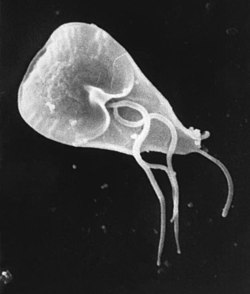Giardiasis
| Giardiasis Klassifikation | |
|---|---|
 Den éncellede organisme Giardia lamblia, der forårsager giardiasis | |
| Information | |
| Navn | Giardiasis |
| Opkaldt efter | Alfred Giard |
| Medicinsk fagområde | gastroenterologi, infektionsmedicin |
| DiseasesDB | 5213 |
| MedlinePlus | 000288 |
| ICD-9-CM | 007.1 |
| Patientplus | giardiasis |
| MeSH | D005873 |
| Information med symbolet | |
Giardiasis er en parasitisk infektion, der er forårsaget af organismen Giardia lamblia.[1][2] Symptomer på infektionen kan omfatte diarre, mavesmerter og vægttab.[3] Opkast, blod i afføringen og feber forekommer sjældnere.[3] Symptomer optræder typisk 1 til 3 uger efter smitte og kan ubehandlet vare op til seks uger.[4] Omkring 10% af de inficerede viser ingen symptomer.[3]
Giardiasis Spreder sig normalt ved at cyster fra Giardia lamblia i afføring forurener fødevarer eller vand, der herefter bliver konsumeret.[3] Det kan også spredes ved kontakt mellem mennesker og andre dyr.[3] Cyster kan overleve i næsten tre måneder i koldt vand.
Forebyggelse af infektion kan ske ved forbedret hygiejne og ved tilstrækkelig varmebehandling af fødevarer.[3] Personer uden symptomer behøver normalt ikke behandling.[3] Personer med symptomer behandles normalt med tinidazol eller metronidazol.[3] Patienter kan midlertidigt blive intolerante overfor laktose efter en infektion.[3]
Giardiasis er en af de hyppigste parasit-infektioner på globalt plan.[1] Forekomsten er så høj som 7% i udviklede lande og 30% i udviklingslandene.[3] World Health Organization har beskrevet lidelsen som en overset sygdom.[3]
I ECDCs (European Centre for Disease Prevention Control) årlige rapport om epidemiologi med data fra 2014 anføres, at der er registreret 17.278 tilfælde af giardiasis i 23 af de 31 lande, der er medlem af EU og EØS. Tyskland har det højeste antal rapporterede tilfælde med 4.011 tilfælde og Storbritannien har det næsthøjeste med 3.628 bekræftede tilfælde.[5]
Referencer
- ^ a b Esch KJ, Petersen CA (januar 2013). "Transmission and epidemiology of zoonotic protozoal diseases of companion animals". Clin Microbiol Rev. 26 (1): 58-85. doi:10.1128/CMR.00067-12. PMC 3553666. PMID 23297259.
- ^ "Giardiasis (beaver fever)". New York State Department of Health. oktober 2011. Arkiveret fra originalen 30. september 2016. Hentet 21. juni 2015.
- ^ a b c d e f g h i j k Minetti, C; Chalmers, RM; Beeching, NJ; Probert, C; Lamden, K (27. oktober 2016). "Giardiasis". BMJ (Clinical research ed.). 355: i5369. doi:10.1136/bmj.i5369. PMID 27789441.
- ^ "Parasites - Giardia". CDC. 21. juli 2015. Arkiveret fra originalen 15. marts 2017. Hentet 30. juni 2018.
- ^ "Giardiasis- Annual Epidemiological Report 2016". European Centre for Disease Prevention and Control. European Centre for Disease Prevention and Control. Arkiveret fra originalen 1. december 2017. Hentet 30. november 2017.
Litteratur
- Kathleen Meyer, How to Shit in the Woods: An Environmentally Sound Approach to a Lost Art, Ten Speed Press (1989). A practical guide to wilderness waste disposal to prevent giardiasis.
Eksterne henvisninger
| Spire Denne artikel om sygdom er en spire som bør udbygges. Du er velkommen til at hjælpe Wikipedia ved at udvide den. |
|
Medier brugt på denne side
Forfatter/Opretter: Anomie, Licens: LGPL
Red plus symbol in a circle, based on Image:Nuvola apps kcmdrkonqi.png
This scanning electron micrograph (SEM) revealed some of the external ultrastructural details displayed by a flagellated Giardia lamblia protozoan parasite. G. lamblia is the organism responsible for causing the diarrheal disease "giardiasis". Once an animal or person has been infected with this protozoan, the parasite lives in the intestine, and is passed in the stool. Because the parasite is protected by an outer shell, it can survive outside the body, and in the environment for long periods of time. Cysts are resistant forms and are responsible for transmission of giardiasis. Both cysts and trophozoites can be found in the feces (diagnostic stages). The cysts are hardy and can survive several months in cold water. Infection occurs by the ingestion of cysts in contaminated water, food, or by the fecal-oral route (hands or fomites). In the small intestine, excystation releases trophozoites (each cyst produces two trophozoites). Trophozoites multiply by longitudinal binary fission, remaining in the lumen of the proximal small bowel where they can be free or attached to the mucosa by a ventral sucking disk. Encystation occurs as the parasites transit toward the colon. The cyst is the stage found most commonly in non-diarrheal feces. Because the cysts are infectious when passed in the stool or shortly afterward, person-to-person transmission is possible. While animals are infected with Giardia, their importance as a reservoir is unclear.

